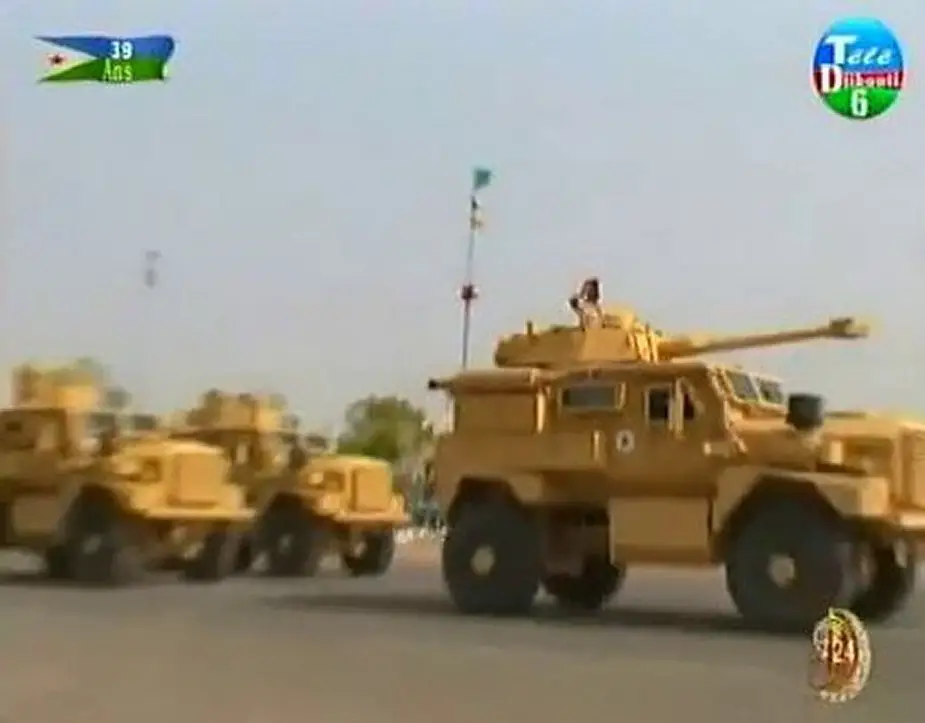Along with other interesting local conversions made in Djibouti as well as in other countries of the region, at least one U.S.-made Cougar MRAP has been spotted with a French-made AML-90 turret, an old device that nevertheless demonstrates the persistent efficiency of this type of armament for local use.

French AML-90 turret on Cougar MRAP (Picture source: Caesar's Twitter account)
The Cougar H 4x4 is an armored personnel carrier in the category of MRAP (Mine Resistant Ambush Protected vehicle). The Cougar is designed and manufactured by the American company Force Protection, now a subsidiary of General Dynamics. The Cougar could be configured to complete a wide variety of mission requirements. The vehicle can serve as a mine-proof troop transport vehicle, a law enforcement special response vehicle, a weapons platform, or an escort protection vehicle. The Cougar was scalable, meaning that it could be used for humanitarian efforts, as well as combat, by detaching the arms and gun systems to look less lethal, but still protected the crew against threats. The Cougar is equipped with multi-point, racing-style harnesses; so, if the vehicle rolled 360 degrees, the passengers inside would avoid injuries. The Cougar 4x4 H can transport six passengers with combat equipment, and can be configured for Command and Control, EOD, Patrol, Convoy Support, Forward Observation, Reconnaissance, Med-Evac and more. The vehicle has been produced since 2002. Several thousands of these vehicles are in service with the US Armed Forces. Other countries of the Cougar MRAP and it's variants are Canada, Iraq, Italy, Poland and the United Kingdom. The Cougar is also used by the British army under the name Ridgeback.
The Panhard AML (Auto-Mitrailleuse Légère, or "Light Machine Gun Car") is a fast, long-ranged, and relatively cheap first-generation armored car with excellent reconnaissance capability. Designed on a small, lightly armored 4×4 chassis, it weighs an estimated 5.5 tonne, thus much lighter than a tank. Since 1959, AMLs have been marketed on up to five continents; several variants remained in continuous production for half a century. These have been operated by fifty-four national governments and other entities worldwide, seeing regular combat.
The AML was once regarded as one of the most heavily armed scout vehicles in service, fitted with a low velocity DEFA D921 90 mm (3.54 in.) rifled cannon firing conventional high explosive and high explosive anti-tank shells, or a 60 mm (2.36 in) breech-loading mortar with 53 rounds and dual 7.5mm MAS AA-52 NF-1 machine guns with 3,800 rounds, all mounted coaxially in the turret. An AML is capable of destroying targets at 1,500 meters with its D921 main gun. In this configuration, it is considered a match for second-line and older main battle tanks. AMLs have appeared most prominently in Angola, Iraq, and Chad, as well as in the Lebanese Civil War between 1975 and 1990. A French company is still marketing refurbished obsolete French army vehicles but the origin of the turrets spotted in Djibouti is unspecified.
Also known as the AML D-90 Lynx, the AML-90 Lynx was a heavily upgraded and modernized AML-90 fitted with a sophisticated turret and ranging system. Like the H-90, the D-90 Lynx turret mounted the same D921 90 mm gun on the right and a co-axial 7.62mm machine gun on the left. The main armament now had an improved elevation gear and could be elevated from −8° to +35°. Other modifications included the replacement of the unlit optical sights with TJN2-90 combined day/night sights. The new sights were designed around a light intensifier tube with automatic gain control to enable sighting in the darkness without the need for artificial illumination and had a range of nearly 2 km (1.2 mi). They could be fitted with additional features such as slope compensation or tachometry facilities. A menagerie of other sights and sighting equipment were also offered with the AML-90 Lynx for export customers, including the same CANASTA night sights package and electronics suite as fitted to the AMX-10RC. The CANASTA system included a low-light television camera and display units for the AML's gunner and commander, along with a moving electronic reticle with sight angle corrections. This somewhat compensated for low hit probability from the first 90 mm round at long range, allowing for the automatic engagement of moving targets.














